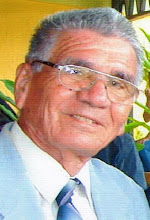Aeronaves
VTOL, información complementaria para todos sobre La Base Miranda
(SVFM).
Por: Enrique Alberto Martín
Cuervo
Me permito informarles y compartir con
Ustedes lo siguiente para que estén en cuenta y se despejen dudas, mitos o
sombras,en relación a las operaciones de Aeronaves VTOL en La Carlota, a saber
:
Estimados amigos actualmente en el mundo las únicas
dos aeronaves, que son aviones y pueden despegar verticalmente (VTOL = Vertical Take Off & Landing)
y que son las más avanzadas en las fases de prueba y de utilización
son:
1) El
Harrier, un avión de combate probado y certificado, que transporta armas, es un
Jet Caza Interceptor, no puede llevar carga, probado en combate y se gano en la
guerra de Las Malvinas, su reputación, para tristeza de America Latina y
ciertamente ninguna guerra es buena.
2) El
Osprey V-22, que usa la Infantería de Marina de USA,
todavía esta en prueba pero en fase muy avanzada, casi por terminar, el puede
transportar personal y carga, pero a nivel mundial no llegan a 30 aeronaves. No
hay versiones civiles y solo las fuerzas militares de USA la tienen, por su
envergadura y tamaño ciertamente requiere de la misma área, grande de seguridad,
para aterrizar que un helicóptero M-26, quizás un poco más. Esta aeronave fue usada en la guerra del
golfo, su participación fue reducida pero adecuada en el transporte de tropas y
su incursión en territorio enemigo, puede hacer vuelo estacionario. NUNCA se ha
utilizado, por ahora en apoyo a desastres o eventos adversos (no se ha probado
en estas actividades). Los sobre nombres ha esta aeronave no son muy buenos
(Flying Bedsteam o “camastro volante”, “Urna Voladora”, “Caja de
Corazones Púrpuras” o “Hacedor de Viudas”), debido a los accidentes
ocurridos (varios) con resultados muy preocupantes, las aeronaves como otros
vehículos siempre tienen accidentes, algo lamentable, pero en aeronaves en
proceso de prueba, estos no hacen mucho bien como paso recientemente con el
Sukhoi Superjet
100 en Indonesia, eso no significa que al ser usadas se caerán o pasara
una desgracia, no, lo que quiere decir es que requiere de más atención,
inspecciones, revisión por hora de vuelo, que el resto de las aeronaves, hasta
que se superen los obstáculos, así paso con los DC-10 y la puerta de carga,
luego de superar los inconvenientes fue y es uno de los aviones más seguro. La
aviación siempre esta alerta por eso los fabricantes emiten boletines de alerta
y boletines técnicos, para garantizar la seguridad de las operaciones, todavía
salen boletines de los DC-3, incluso hasta de las Cessnas 206, 182, etc., pues
la seguridad no se detiene, esta en movimiento para salvar vidas (prevención de
accidentes – PREVAC). El V-22 será sin lugar a dudas la maquina del futuro y
seguramente la aviación caminara al vuelo VTOL, pero el trecho es muy largo para
llegar todavía a ese futuro, quizás más de 50 años, dependiendo de los
resultados y las vivencias de la operación del V-22 hoy, que gracias al Harrier
es que se comenzaron a dar los pasos en este camino (es adecuado indicar que no
hay aeronave mala, todas tienen sus ventajas, desventajas y características
técnicas, performance que debe y tiene que ser considerado). Pero por ahora no
es la mejor y más eficiente opción.
Por tanto, visto lo anterior ninguna de estas dos (2)
aeronaves, pudiera ser usada en caso de un desastre, la primera es un avión de
combate, la segunda, todavía requiere ser probada y sus mejoras están escrita
con la sangre de los que murieron en los accidentes, por tanto debemos
contemplar por ahora, el uso de aviones STOL entre otros y helicópteros, esto no
es un mito señores, ni cuentos chinos es una realidad operacional, por eso en mi
escrito remitido de La
Carlota no hable de estas dos (2) aeronaves, lo demás no existe
o no son ni eficientes como por ejemplo: El AW-609 (todavía sin certificación en
prueba, pero no es muy grande caben 12 personas, es como un helicóptero
mediano), un globo, dirigible, un ultraliviano y lanzar carga en paracaídas es
posible pero complejo, hay que dedicarle tiempo para una explicación técnica
detallada, hay un riesgo y hay que evaluarlo, pero no hay duda más seguro y
eficiente es la pista. Creo que por eso existen los expertos en cada área y por
eso me permito nutrirlos con información verdadera y no mitológica o utópica,
sino concreta, real y veraz, para que así puedan evaluar el contexto general y
tomar una decisión adecuada para el bien común, no mis deseos, sino el bien a
tutelar que es la seguridad en la acepción más grande de esta palabra, sin dejar
nada por fuera, como diría un buen amigo.
Aquí les anexo unos artículos sobre estas
aeronaves para información general, disculpen que la mayoría este en ingles por
favor:
dice-que-los-aviones-osprey-
Panetta
dice que los aviones Osprey no volarán hasta que Japón despeje las dudas de
seguridad
04 de agosto de 2012
• 00:22
Foto:
EFE en español
El secretario de Defensa de EEUU, Leon Panetta,
garantizó hoy a Japón que los aviones militares Osprey que desplegará en la
provincia de Okinawa son seguros y no realizarán vuelos hasta que el Gobierno
nipón despeje las dudas sobre su seguridad.
Panetta se reunió en Washington con el ministro nipón
de Defensa, Satoshi Morimoto, y ambos hablaron de las preocupaciones que ha
despertado en Japón el despliegue de los Osprey por las dudas sobre su seguridad
después de que aviones de este tipo hayan estado implicados en recientes
accidentes en Marruecos y en Florida (EEUU).
"En reconocimiento de las preocupaciones del Gobierno
japonés sobre la seguridad de esa aeronave, nos abstendremos de cualquier
operación de vuelo en Japón en el corto plazo", dijo el jefe del Pentágono en
una rueda de prensa tras la reunión con Morimoto.
Según Panetta, el Departamento de Defensa de EEUU
presentará durante este mes al Gobierno japonés los resultados de la
investigación de los accidentes recientes que involucraron a aviones Osprey para
que pueda "reconfirmar" la seguridad de sus operaciones.
Hoy mismo el ministro nipón "tendrá la oportunidad de
ver de primera mano la impresionante capacidad del avión", agregó
Panetta.
En la misma línea, Morimoto explicó que, hasta que se
confirme su seguridad, Estados Unidos "se abstendrá de volar los Osprey en
Iwakuni".
Los aviones llevarán a cabo pruebas de vuelo en
Iwakuni (suroeste) antes de ser trasladados a finales de año a la isla de
Okinawa (sur), donde EEUU mantiene la mitad del contingente de cerca de 48.000
soldados que tiene en Japón.
Este año los dos países acordaron la salida de 9.000
soldados estadounidenses de Okinawa, que acoge a la mayor parte de la presencia
militar de EEUU en Japón desde el fin de la Segunda Guerra
Mundial.
Este acuerdo satisface las demandas de Tokio, que se
quejaba de la fuerte presión y roces con la población civil que supone la
presencia de unos 19.000 soldados en un territorio insular tan
pequeño.
doc500dabd5503b0127635118.txt
Boeing's V-22
Osprey aircraft arrive in Japan amid protests (With
Video)
Published:
Monday, July 23, 2012
BY ERIC
TALMADGE,
Associated Press
Ground crew members fit
out a MV-22 Osprey at U.S. Marine Corps Air Station Iwakuni in Iwakuni,
Yamaguchi Prefecture, western Japan, Monday, July 23, 2012. A shipload of the
U.S. military's latest transport aircraft arrived in Japan on Monday amid
protests over safety issues that have aggravated longstanding grassroots concern
over the presence of American bases in the country. (AP Photo/Kyodo
News)
TOKYO (AP) — A
shipload of the U.S.
military's latest transport aircraft arrived in Japan
on Monday amid protests over safety issues that have aggravated longstanding
grassroots concern over the presence of American bases in the
country.
Workers began unloading and assembling the 12 MV-22 Osprey -
which are partially made at the Boeing plant in Ridley Township - in the city of Iwakuni soon after the ship
arrived. The U.S. plans to
deploy the tilt-rotor aircraft to Okinawa to
replace older CH-46 helicopters that are already there.
The Osprey
deployment has become the latest rallying point for base opponents and a serious
headache for officials in Tokyo and Washington hoping to calm
anti-base sentiment.
Although the
Ospreys will only be in Iwakuni briefly, opposition there has been unusually
strong, with both the mayor and the governor saying they do not support even
temporarily hosting the aircraft. Opposition to the large military presence on
Okinawa is deep-rooted, and protesters on
Monday held a sit-in outside the base where the Ospreys are to be
sent.
Residents and local leaders in Iwakuni and on Okinawa have demanded the plan be scrapped because they
say the planes are not safe. Such concerns boiled over after Osprey crashes in
Morocco in April and in
Florida last
month.
Hundreds of protesters turned out to demonstrate against the
arrival, some of them aboard small boats.
The planes have been used
extensively in Iraq and
Afghanistan, and the
United
States says they have a solid record. The
Osprey can fly like an airplane and has tilting rotors that allow it to take off
and land like a helicopter. It can fly much faster and carry bigger loads than
the CH-46, which it is replacing worldwide.
"Deployment of these aircraft
in Japan is a vital component
in fulfilling the United
States' commitment to provide for the defense of Japan
and to help maintain peace and security in the Asia-Pacific region," the U.S.
Embassy said in a statement Monday.
The United States has about 19,000 Marines on
Okinawa, which also hosts a large U.S. air base. More than half of the
roughly 50,000 U.S. troops
stationed throughout Japan
are based on Okinawa.
-------------------------
14-06-2012.
USA.
Air Force Osprey
crash at Florida base injures five
Hurlburt Field,
Florida (CNN) -- An Air Force CV-22 Osprey crashed Wednesday during a routine
training mission north of Navarre, Florida, injuring five crew members aboard, a
military official said.
The crash occurred about 6:45 p.m. at
Hurlburt Field's Eglin Range, said Amy Nicholson, chief of public
affairs at the airfield.
The five injured crew members were taken
to an area hospital, Nicholson said. The extent of their injuries was not
immediately known.
The cause of the accident is under
investigation, she said.
The Osprey was assigned to the 1st Special
Operations Wing, the Air Force said. The tilt-rotor aircraft can fly like an
airplane and land like a helicopter.
The Army began developing the
Osprey in 1982, though the program was nearly scrapped in 1989 when
then-Secretary of Defense Dick Cheney sought to cancel it because of ballooning
costs.
Questions were raised about the safety of the Osprey after
two crashes, including one in 1992 at a Marine Corps air base in Virginia that killed the
crew.
In late 2000, the Marine Corps grounded the Osprey fleet
after two crashes -- one in Arizona that killed
four crew members and 15 passengers, and another in North Carolina that
killed the crew.
A redesign was ordered on the Osprey, and it
resumed flights in 2002.
The Air Force began using Ospreys in 2008
after testing the aircraft in 2006. They were first deployed by the Marines in
Iraq in 2007 after 18 years and $20
billion in development.
-------------------------
26-07-2012.
Japon.
US Military
Grounds F-16s After Crash off Japan
TOKYO July 26,
2012 (AP) A squadron of U.S. F-16 fighter jets in Japan has been grounded for
safety checks after one of their aircraft crashed in the Pacific, military
officials said Thursday.
The crash
comes as an uproar in Japan
has been raised over the deployment of the U.S. Marine Corps' latest transport
plane, the MV-22 Osprey, to the southern island of Okinawa. Two Ospreys have crashed since
April and swelling opposition to their deployment has become a major political
headache for Tokyo and Washington.
The F-16 with the
35th Fighter Squadron at Misawa Air Base crashed Sunday about
250
miles (400 kilometers) off the coast
of Hokkaido, Japan's
northernmost main island. It was the first crash of an F-16 out of Misawa since
2002.
Staff Sgt. Nathan Lipscomb said the 45 F-16s at Misawa, which
is the northernmost U.S. air
base in Japan, have been grounded pending
safety checks. He said an investigation into the cause of the crash was under
way. The aircraft was en route to Alaska when it went down Sunday
morning.
The pilot, whose name has not been released, ejected
safely and was retrieved after about six hours by a Japanese and U.S.
rescue mission. Lipscomb said the pilot is in stable condition and has been
taken to a U.S. facility -
reportedly in Alaska - but will return to Misawa. He could
not immediately provide further details.
The United States has about 50,000 troops stationed
throughout Japan under a mutual security
pact.
Though Misawa is relatively remote and F-16 crashes rare,
concerns over accidents, noise and base-related crimes are endemic in many areas
that host the U.S. troops.
Such
concerns are especially sensitive on Okinawa, which is home to most of the
troops, and the outcry over the Osprey deployment has focused national attention
on the potential dangers of U.S. military
aircraft.
To help ease the
uproar, U.S. and Japanese
officials met in Tokyo on Thursday to discuss ways to assure the
safe operation of the Ospreys in this country. The first 12 Ospreys arrived
earlier this week for assembly in the city of Iwakuni and are to be deployed to Okinawa soon, though local officials have strongly
criticized the plan.
http://bigstory.ap.org/article/us-military-grounds-f-16s-after-crash-japan
Accidents_and_incidents_
Accidents and
incidents involving the V-22 Osprey
From Wikipedia, the
free encyclopedia
Jump to: navigation,
search
USAF CV-22 Osprey
flies a test mission
The Bell
Boeing V-22 Osprey is an American
military tiltrotor
aircraft.
The aircraft was developed by Bell
Helicopter, which manufactures it in partnership with Boeing
Helicopters.
There have been four
significant failures during flight testing,[1]
one combat-zone crash,[2]
and a number of minor incidents.
A dozen V-22s have allegedly been scrapped after unreported mishaps.
Contents
|
[edit] Crashes
The V-22 has had 7
crashes with a total of 36 fatalities.
[edit] June 1991
A miswired flight
control system led to two minor injuries when the left nacelle
struck the ground while the aircraft was hovering
15 feet
(4.6 m) in the air, causing it to bounce and catch fire on 11 June
1991.[1]
The pilot, Grady Wilson, suspected that he may have accidentally set the
throttle lever the opposite direction to that intended, exacerbating the crash
if not causing it.[4]
[edit] July 1992
On 20 July 1992,
pre-production V-22 #4's right engine failed and caused the aircraft to drop
into the Potomac
River by Marine
Corps Base Quantico with an audience of congressmen and other
government officials. Flammable liquids collected in the right nacelle and led
to an engine fire and subsequent failure. All seven on board were killed and the
V-22 fleet was grounded for 11 months following the accident.[5][6][1]
[edit] April 2000
A V-22 loaded with Marines,
to simulate a rescue, attempted to land at Marana
Northwest Regional Airport in Arizona
on 8 April 2000. It descended faster than normal (over 2,000 ft/min or
610 m/min) from an unusually high altitude with a forward speed of under
45
miles per hour (72 km/h) when it suddenly stalled
its right rotor at 245
feet (75 m), rolled over, crashed, and
exploded, killing all nineteen on board.[7][8]
The cause was
determined to be vortex
ring state (VRS), a fundamental limitation on vertical descent which
is common to helicopters.
At the time of the mishap, the V-22's flight operations rules restricted the
Osprey to a descent rate of 800 feet per minute (4.1 m/s) at
airspeeds below 40 knots (74 km/h) (restrictions typical of
helicopters); the crew of the V-22 in question exceeded this operating
restriction with a rate more than 100% greater.[9]
Another factor that
may have triggered VRS was their operating in close proximity, which is believed
to be a risk factor for VRS in helicopters. Subsequent testing has shown that
the V-22, and the tiltrotor in general, is less susceptible to VRS, the
conditions are easily recognized by the pilots; recovery from VRS requires a
more natural action by the pilot than recovery in helicopters, the altitude loss
is significantly less than for helicopters, and, with sufficient altitude
(2,000 ft/610 m or more), VRS recovery is relatively easy.[1]
As a result of
testing, the V-22 will have a descent envelope as large as or larger than most
helicopters, further enhancing its ability to enter and depart hostile landing
zones quickly and safely. The project team also dealt with the problem by adding
a simultaneous warning light and voice that says "Sink Rate" when the
V-22 approaches half of the VRS-vulnerable descent rate.[1]
[edit] December 2000
On 11 December
2000, a
V-22 had a flight control error and crashed near Jacksonville,
North Carolina, killing all four aboard. A vibration-induced chafing
from an adjacent wiring
bundle caused a leak in the hydraulic
line which fed the primary side of the swashplate
actuators
to the right side rotor blade controls. The leak caused a Primary Flight Control
System (PFCS) alert. A previously undiscovered error in the aircraft's control
software caused it to decelerate in response to each of the pilot's eight
attempts to reset the software as a result of the PFCS alert. The uncontrollable
aircraft fell 1,600
feet (490 m) and crashed in a forest. The
wiring harnesses and hydraulic line routing in the nacelles were subsequently
modified. This caused the Marine Corps to ground its fleet of eight V-22s, the
second grounding in 2000.[1]
[10][11]
[edit] April 2010
On 8 April
2010, a
USAF CV-22 crashed in southern Afghanistan.[2]
Three US service members and one civilian
were killed and 16 injured in the crash.[12]
It was initially unclear if the accident was the result of enemy fire.[13][14]
The loaded CV-22B was at its hovering capability limit, landing at night near
Qalat (altitude approx. 5,000 feet) in brownout
conditions, in turbulence due to the location in a gully.[12][15]
The USAF investigation ruled out brownout conditions, enemy fire, and vortex
ring state as causes. The investigation found several factors that significantly
contributed to the crash; these include low visibility, a poorly executed
approach, loss of situational awareness, and a high descent rate.[16]
Brig. Gen. Donald
Harvel has fingered the "unidentified contrails" during the last 17 seconds of
flight as indications of engine troubles.[17]
The actual causes of the crash may never be known because US military aircraft
destroyed the wreckage and black box recorder.[18]
[edit] April 2012
On 11 April 2012, an
MV-22 from the VMM-261
on USS Iwo
Jima (LHD-7) crashed near Tan Tan and Agadir,
Morocco,
during a joint training exercise, named "African Lion". Two Marines were killed
and two others were seriously injured, and the aircraft was lost.[19][20][21]
U.S. investigators found no mechanical flaw with the aircraft,[22]
and human error was determined as the cause.[23]
[edit] June 2012
On 13 June
2012, a
USAF CV-22 crashed at Eglin Air
Force Base in Florida during training. All five aboard were
injured;[24]
two were released from hospital shortly after.[25]
The aircraft ended upside down and received major damage.[26]
The cause of the crash is being investigated.[26][25][27]
[edit] Other accidents and notable
incidents
[edit] Early 2006
A V-22 experienced an
uncommanded engine acceleration while ground turning at Marine
Corps Air Station New River. Since the aircraft regulates power turbine
speed with blade
pitch, the reaction caused the aircraft to go airborne with the
Torque Control Lever (TCL, or throttle)
at idle. The aircraft rose 30
feet (9.1 m) into the air, and then fell to the
ground with enough force to damage one of its wings; the total amount of damage
was approximately US$7 million.[28]
It was later found that a miswired cannon plug to one of the engine's two Full
Authority Digital Engine Controls (FADEC)
was the cause. The FADEC software was also modified to decrease the amount of
time needed for the switch between the redundant FADECs to eliminate the
possibility of a similar mishap occurring in the future.[29]
[edit] July 2006
A V-22 experienced compressor
stalls in its right engine in the middle of its first transatlantic
flight to the United
Kingdom for the Royal
International Air Tattoo and Farnborough
Airshow on 11 July 2006.[30]
It had to be diverted to Iceland
for maintenance. A week later it was announced that other V-22s had been having
compressor surges and stalls, and the Navy
launched an investigation into it.[31]
[edit] February 2007
The Air
Force and Marine Corps commands temporarily grounded their entire
fleet on 10 February 2007 after discovering a glitch in a computer
chip that could cause the aircraft to lose control.[32]
[edit] March 2007
A V-22 experienced a
hydraulic leak that led to an engine-compartment fire before takeoff on 29 March
2007.[33]
It was also reported at that time that a more serious nacelle fire occurred on a
Marine MV-22 at New River in December
2006.[33][34]
[edit] November 2007
An MV-22 Osprey of VMMT-204
caught fire during a training mission and was forced to make an emergency
landing at Camp
Lejeune on 6 November 2007. The fire, which started in one of the
engine nacelles, caused significant aircraft damage, but no injuries.[35]
After an
investigation, it was determined that a design flaw with the engine air particle
separator (EAPS) caused it to jam in flight, causing a shock wave in the
hydraulics system and subsequent leaks. This hydraulic fluid leaked into the IR
suppressors and was the cause of the nacelle fires. As a result, all Block-A
V-22 aircraft were placed under flight restrictions until modification kits
could be installed. No fielded Marine MV-22s were affected, as those Block-B
aircraft already incorporated the modification.[36]
[edit] FY 2009
An Air Force CV-22
suffered a Class A mishap with more than a $1 million in damage during FY 2009.
No details were released.[37]




















.jpg)















.jpg)
.png)






